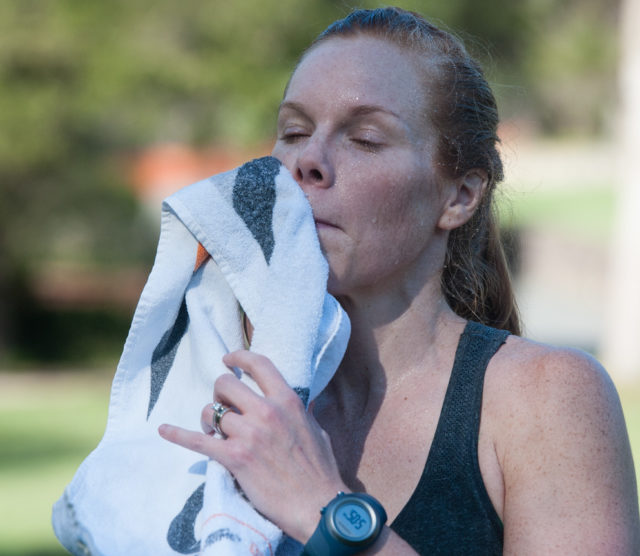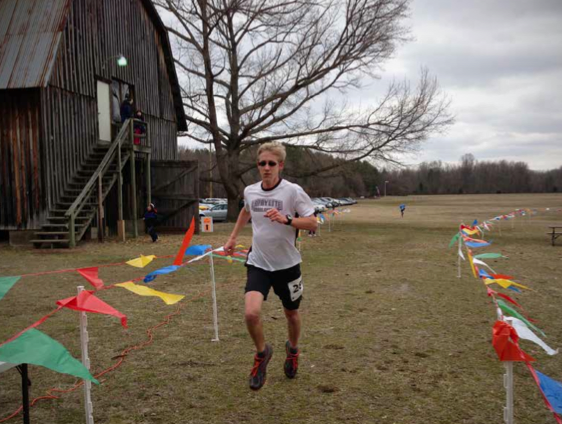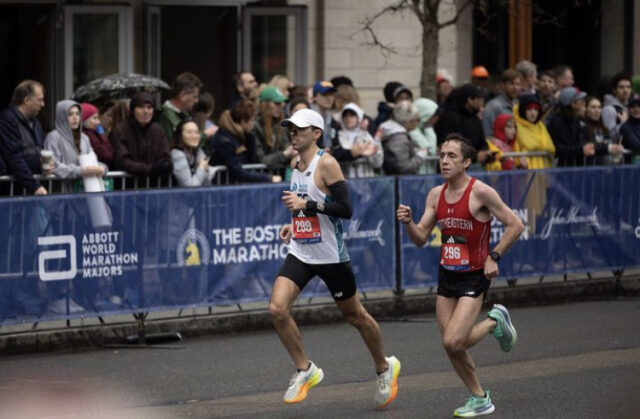
Editor’s note: This was originally published in 2016, but this seems like a good time to revisit it.
Summertime in DC: stepping out the front door is like stepping into a sauna. You don’t generally notice air, but today its presence is palpable and oppressive, a thick cloud that weighs on you and seems to stall your forward progress. Within seconds you’re sweating buckets, water pouring off you in all directions. What is this torture?
It’s not the heat; it’s the humidity.
“I hate it,” said Chelsea Cox, who lives in D.C. and competed in the 800 meters at the 2016 USA Track and Field Indoor Championships. “It’s just miserable to me, especially when the heat gets high.”
Humidity’s misery comes from its disruption of the body’s cooling system. “The basic mechanism by which we cool ourselves in the heat is by sweating,” said Dustin Slivka, an exercise physiologist at the University of Nebraska at Omaha. But, “Sweating alone doesn’t cool our body. What cools our body is the evaporation of the sweat off our skin.” When the air is already saturated with water–as on humid days–the water on our skin has nowhere to go. “When there’s high humidity that sweat is less likely to evaporate off our skin. It’s more likely to just roll of us and create a puddle, which does us no good from a thermoregulation cooling standpoint,” Slivka said.
And if your body isn’t cooling properly, running becomes a struggle. More blood is shunted to the skin in a fruitless attempt to release some of the heat through sweat, but this means less blood is sent to the muscles. The result? You slow down.
But perhaps it’s not all bad. “In order to get adaptations in the body, you have to stress it,” said Santiago Lorenzo, who competed in the decathlon at the 2004 Olympics and is now an exercise physiologist and professor at Lake Erie College of Osteopathic Medicine-Bradenton in Florida. One well-known method of stress is to spend a few weeks living or training at altitude. Runners flock to places like Flagstaff, Ariz. or Boulder, Colo. to breathe in the less oxygenated air and force their bodies to make do. They return to sea level with tougher, stronger systems — full of more red blood cells to carry oxygen to working muscles faster — and, they hope, improved race times.
Some say humidity is the poor man’s altitude. Might our struggles in the summer stuffiness pay off in a similar way come fall?
Although humidity hasn’t been well studied, we do know that exercising in the heat — the other half of the DMV’s brutal summer combo — can lead to big improvements in performance.
While in graduate school at the University of Oregon, Lorenzo studied if heat acclimation improves cyclists’ performance. Compared to doing all workouts in ideal conditions, he showed that doing some easy rides in the heat–while still doing the harder, intense workouts in cooler temperatures–improved time trial performance by 8 percent in hot conditions and 6 percent in cool conditions. (An 8 percent improvement would mean a 2-minute PR for a 25-minute 5k runner.) The hotter sessions forced the athletes’ bodies to adapt by increasing blood volume, cardiac function, and sweat rate and these improvements boosted performance no matter the temperature.
However, temperature was the only variable in the study; humidity was low in all the conditions. Adding the element of humidity is next on many researchers lists, but hasn’t yet been investigated.
Still, Lorenzo suspects humidity could have advantages, just as heat does, by stressing the body and forcing it to work a bit harder.
“In a way [humidity] could even be beneficial,” he said. “You’re not able to cool your body off as efficiently because of the high humidity, but in the end your body will keep trying to adapt. In that process your thermoregulatory system will keep being pushed to be improved.”
Christopher Minson, a physiologist at the University of Oregon and Lorenzo’s graduate school advisor, is currently studying overdressing, the non-D.C. man’s humidity. By wearing additional layers, you block the evaporative cooling effect. Many athletes use this technique to prep for hot weather races. (Maegan Krifchin, of Silver Spring, did this ahead of her seventh place finish in this year’s steamy Olympic Trials marathon.)
Minson suspects overdressing (and, by correlation, humidity) causes some adaptations by raising the body’s core temperature. When the body temperature rises, it activates proteins that help create the physiological changes and adaptations. “We think a large part of the adaptation to training in the heat is getting your core temperature above a certain threshold,” Minson said. Since sweating provides little cooling on humid days, those conditions may also raise the body temperature above the critical threshold. Although Minson isn’t sure humidity alone will work as well as heat, fortunately, in D.C., we have both.
But is our heat and humidity combo analogous to altitude?
Not quite. For one thing, Lorenzo says the mechanisms are completely different. Altitude boosts red blood cell production, which could help to deliver more oxygen to the muscles. Heat (and possibly humidity) increases blood volume and sweating.
Slivka agrees they’re not synonymous. “Some of the same outcomes may be seen from slightly different mechanisms.” Both might lead to performance benefits, but for different reasons.
But Cox, who has trained at altitude, thinks the two can wear on your in similar ways. When in Flagstaff, “No matter how much I slept, or how much caffeine I drank, I never felt like I was fully caught up on my energy,” she said. “I can definitely relate that to the humidity in DC. You’re always feeling bogged down even hours after you train; it still feels like you need a lot more to get your energy back up.”
How can we cope with the sluggishness?
Krifchin, who has also trained in Flagstaff, emphasizes recovery. “Recovery is key in any type of training, whether you’re in the most ideal climate or not.” Make sure to rehydrate well to replace that sweat puddle you left behind.
And accept slower times during summer’s hot and humid days. Don’t expect to run the same pace at a steamy Independence Day race as you would at a crisp Turkey Trot. Runners training at altitude know they won’t hit the same paces as they can at sea level, but aren’t worried about it. But, just like the effects of altitude living pay off at sea level, Lorenzo’s study showed heat training improves performance even when the weather cools, so that Turkey Trot could go even better than expected.
Kathy Pugh, a running coach and director of training for the D.C. Road Runners Club, agrees that it will pay off come fall. But, in the meantime, she recommends caution. Heat and humidity are “nature’s way of telling you to dial it back a bit,” she said. “I would advise people to go easier.” She encourages all runners to be extra careful about hydration, go with friends, stick to shaded routes, and run at dusk or dawn, especially for speed work sessions. Note that the athletes in Lorenzo’s study did their intense workouts in cool conditions, so an indoor treadmill would be another great option.
And, of course, be patient. “For the very first few sessions maybe you’ll have to run a little slower, maybe for a shorter amount of time, but eventually the body will adapt and it will get easier,” said Lorenzo. “You just have to stick with it and listen to your body so you do not get too hot.”
“Know that it’s going to feel uncomfortable and miserable at times, but embrace that rather than be scared of it,” said Cox. “It makes you a much tougher athlete.”
Krifchin agrees. “I think grinding it out in heavy heat and humidity where you’re drenched in sweat and you’re getting slightly dehydrated, that brings out that mental toughness and the hardcore component. It gives you a little bit of an edge on your race competitors.”
- Three women with D.C.-area connections will represent the United States in the marathon at the World Athletics Championships Aug. 26 in Budapest (I’m aware of the mistake in the email’s subject line). Reston’s Susanna Sullivan, who ran at George Mason (now Meridian) High School, will make her first U.S. team. Keira D’Amato, who ran at Oakton High School and American University, was eighth in last year’s World Championships Marathon in Oregon. Lindsay Flanagan, now in Colorado, lived in Silver Spring early in her professional career while running for Riadha.
- James Madison High School cross country and track coach Craig Chasse won the VHSL Lifetime Achievement Award.
- Woodbridge High School alumnus Alex Taylor qualified for his second Olympic Marathon Trials at Grandma’s Marathon, running 2:17:30.
-
General registration for the Marine Corps Marathon has sold out, though you can still run for a charity, register through a premium package that includes a hotel room, transportation and race day perks, or transfer a bib.
- Washington Latin alumnus Luke Tewalt will represent Wake Forest in the 5,000 meters and Tuscarora alumnus Derek Johnson will represent Virginia in the 3,000 meter steeplechase at the NCAA Championships. Read more about Tewalt in a profile written by Wake Forest student Cooper Sullivan.
- Saturday will mark the third Chocolate City Relay, a DIY event organized by Black women. You can catch the relay at around 2 p.m. at the Fort Stanton Rec Center or around 4 p.m. at the Hains Point parking lot. Read about the 2022 relay.
- D.C. resident Gina McNamara, representing Malta, won gold medals in the 800 meters, 1500 meters and 5000 meters at the Games of the Small States of Europe.
The various state championships wrapped up last weekend and Herndon senior Gillian Bushee completed the distance sweep for the year, winning Virginia’s 6A titles in cross country, along with the indoor and outdoor 1600 meters and 3200 meters.
In non-championship news, St. Andrews senior Tinoda Matsatsa, ran 3:58.70at the HOKA Festival of Miles in St. Louis, making him the first Black high school student to break the four-minute mile barrier.
Local state champions:
D.C.
800 Lorelei McIntosh – St. John’s 2:19.01
1600 Meredith Gotzman – St. John’s 5:08.41
3200 Gotzman 11:13.99
4×800 St. John’s College (Sophie Mattheus, Kendall Robinson, Lorelei McIntosh, Meredith Gotzman) 9:32.82
800 Pierre Attiogbe – St. Albans 1:59.29
1600 Attiogbe 4:06.66
3200 Sebi Hume – St. Albans 9:46.74
4×800 St Albans (William Strong, Hume, Liam Quinn, Attiogbe) 7:50.48
Maryland 4A
800 Grace Finnegan – Richard Montgomery 2:17.29
1600 Victoria Ketzler – Thomas Wootton 4:58.29
3200 Katherine Greenwald – Walt Whitman 10:49.37
4×800 Walter Johnson – MacKenzie Raue, Zuzana Huserova, Carolyn Hultman, Megan Raue – 9:29.82
800 Gage Osborne – Northwest 1:55.9
3200 Alejandro Berrio – Seneca Valley 9:28.62
4×800 Montgomery Blair – Frederick Alfonso, Erich Ramos, Micah McKenzie, Alexander Risso – 7:58.48
Virginia 6A
800 Kenza Elakari – West Springfield 2:11.72
1600 Gillian Bushee – Herndon 4:56.14
3200 Bushee 10:30.46
4×800 South Lakes – Aya Ryan, Catalina Simon, Caroline Elliott, Bella Harsanyi – 9:00.11
800 Iyasu Yemane – Oakton 1:55.42
4×800 South County – John Baxter, Isaac Garcia, Nayan Kasperowski, Kian Khorashadi – 7:49.88
Virginia 5A
800 Annie Sullivan, Annie Stone Bridge 2:16.66
Virginia 3A
1600 Grace Crum Meridian 4:59.88
VISAA Championships, Division I
800 Reagan Exley – Potomac School 2:19.8
1600 Exley 5:09.12

Patuxent River Park in Upper Marlboro, Md. boasts more than 6,000 acres of nature trails and wildlife just ten miles off the Beltway.

Rockville’s Dylan Hernandez (2:26:02) and D.C.’s Madeline Hartlieb (2:57:52) were the first D.C.-area runners across the finish line at the 127th Boston Marathon.
Despite facing strong headwinds in the closing miles of the race, Hillary Bor broke the men’s American record for 10 miles at the Credit Union Cherry Blossom Ten Mile Sunday, running 46:11 for second overall. He trailed Ethiopia’s Tsegay Kidanu by three seconds. Bor ran the 3,000 meter steeplechase on the U.S. Olympic team in 2016 and 2020, finishing seventh in 2016. Greg Meyer set the previous record of 46:13 at Cherry Blossom in 1983. Results Photos
Once again, the race served as the USATF 10 mile championships, and Sara Hall won the women’s division in 52:37, finishing behind second overall Uganda’s Sarah Chalangat’s 52:04. Vienna’s Perry Shoemaker broke the American record for women ages 50-54 with her 1:00:37.
Reston’s Susanna Sullivan, last year’s overall winner, was the D.C. area’s top finisher in seventh place, running 53:25. D.C.’s Zach Herriott was the top local man, running 48:57 for 14th place. Herriott won the race’s virtual competition in 2020. Bethesda’s Ben Beach completed the race, having run each Cherry Blossom dating back to when the race was started by the D.C. Road Runners
The race’s 50th running brought a new focus to the 5k race, which had previously been held as an alternative to the 10-mile distance. The race was held a day earlier and moved to a flat course starting at Freedom Plaza, where Baltimore’s Johan Fagerberg (15:03) and D.C.’s Casey Greenwalt (18:13) each won their respective races.
- The Montgomery County Planning Board will hold a public hearing at 5:30 pm March 30 on the Liittle Falls Parkway road diet, which has closed two lanes of the road for a half-mile stretch, allowing for recreational use. The county planning staff has recommended the program continue.
- The Zoo Loop in Rock Creek Park is now open through 7 p.m.
- D.C.’s Tim Choi was a guest on the Micromobility DC podcast.
- The Road Runners Club of America honored several local runners through the 2022 National Running Awards program:
- Conroy Zien and Sarah Day for their role leading the Mongtomgery County Road Runners Club’s First Time Marathon program – Outstanding Beginning Running Program. Zien was named Best Running Coach in the 2015 Best of Washington Running.
- Kelyn Soong of the Washington Post – Excellence in Running Journalism. Soong wrote for RunWashington for several years.
- Jean Arthur of Silver Spring – Browning Ross Spirit of the RRCA.
Check out some mile seven photos from the Rock ‘n’ Roll D.C. Half Marathon. If you use any, please credit Charlie Ban/@RunWashington. Or be a jerk and don’t.
- Saturday’s Rock ‘n’ Roll Half Marathon will include changes to the latter miles of the race, with the finish moving to Judiciary Square from its longtime home at RFK Stadium. The start of the race will include a trip over the Arlington Memorial Bridge after several years away.
- The Potomac Valley Track Club was a close second at the USATF Masters Indoor Track Championships. Vienna’s Perry Shoemaker ran 10:07.36 to set an American record for the indoor 3,000 meters for the 50-54 age group.
- Registration has opened for this year’s Army Ten-Miler.
- The Chocolate City Relay is accepting applications for the group’s June 10 event around Washington, D.C. Apply here
- After its winter hiatus, the District Running Collective will resume its Wednesday night runs this week. RVSP here
- South Lakes’ girls 4×800 team finished second at New Balance Indoor Nationals.

